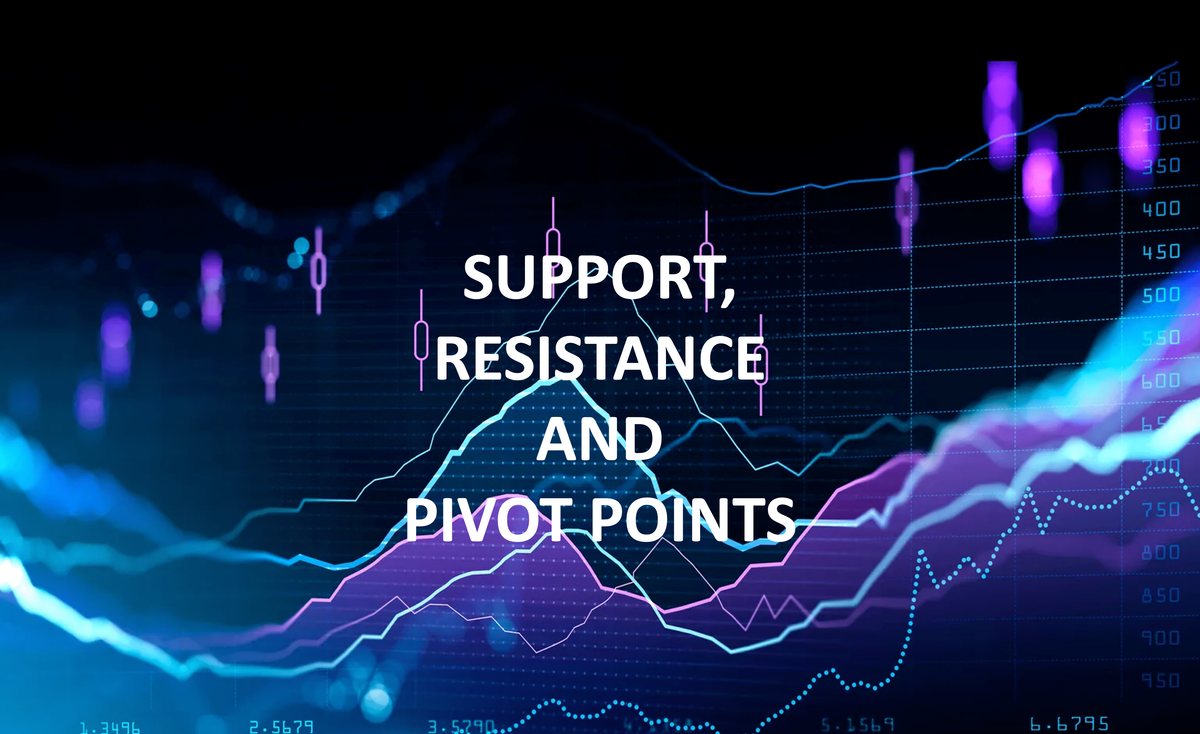How to Use Pivot Support and Resistance to Master the Markets
Get ahead of the competition by mastering pivot support and resistance! Learn how to identify profitable intraday trades with our comprehensive guide.

Mastering pivot support and resistance analysis can give you an edge over other traders in the market. In this guide, we'll show you how to identify intraday price levels that may act as support and resistance, so that you can capture profitable opportunities.
What is Pivot Support and Resistance?
Pivot support and resistance is a type of technical analysis which determines levels of significant intraday price points that have the potential to act as support or resistance depending on the direction of the market. By exploiting this knowledge, traders can better time their entry and exit points within a trading day.
Pivot support and resistance is determined by taking the highs, lows and closing prices of a given period, usually a single trading day, and calculating mathematical levels known as "pivot points" using these values. These pivot points are levels at which there is likely to be an influx of buyers or sellers, causing the price of a security to rise or fall. Traders will want to pay attention to even minor differences in levels provided by their charting software as this can indicate where the real intraday support and resistance lies. While no two security offers the same technical analysis experience due to different volatility, Pivot Support and Resistance can still provide valuable insight into the movement of a security's price. This knowledge can be used to trade the futures market effectively.
How to Calculate Pivot Points
To calculate pivot points, traders need to observe the previous day’s highs and lows as well as the closing price. These three numbers are then used in a formula which takes into account the varying heights of highs, lows, and closings from day-to-day. The formula calculates important intraday levels that may act as support or resistance at different price values depending on their direction.
Photo by Chris Liverani / Unsplash
Knowing these levels is important as they can help traders identify entry and exit points in the market. Whenever price trends approach a support or resistance line, its repeated tests back-and-forth indicate that the trend may reverse. Therefore, traders should pay attention to these values when plotting technical charts. It’s also important for traders to recognize that there are different types of pivot point calculations based on their opening value such as classical and Woodie’s pivot points. Thus, it is essential for traders to customize their formula according to their trading style and objectives.
Factors Influencing Pivot Points
While it’s important to understand the general methodology of how pivot points are calculated, traders should also take into account a number of different influencing factors. These include the overall sentiment of the market, news events and announcements, currency fluctuations, and technical indicators. All of these will impact where strong support or resistance areas might form during intraday trading activity.
Sentiment of the market can play a key role in the formation of pivot support and resistance. If the market is feeling bearish then traders will be more inclined to short certain assets when it reaches or passes through a major level. Similarly, if the market is feeling bullish, traders will be more likely to initiate long positions at these key points. Currency fluctuations can also form an important part in pivot analysis, particularly when talking about how different markets interact with one another. Technical indicators may display signs that a support/resistance area has formed and should act as confirmation signals to potentially trade around points of possible volatility. It's also essential not to forget any news events or announcements that may affect the strength of support and resistance levels in both directions.
Using Support and Resistance Levels to Trade
One of the most effective ways to use pivot points is to set a trade order at one of the intraday support or resistance levels. When the market hits either of these price points – or any variation thereof – traders may decide to enter a trade long if above the support level, or short if below a resistance level. When trading in this way, it’s advised that traders set tight stops for losses and take profits near the next line of support or resistance.
Photo by Neil Thomas / Unsplash
When setting up trades with pivot points, traders should also pay attention to the one-hour chart prior to the open of a new day. This will help them establish more accurate support and resistance points, as the hourly data excludes most of the market’s overnight activity. This can also be useful when attempting to set options and futures trades using pivot points – traders may be able to gain deeper insight into intraday market behavior by examining shorter timeframe charts for additional information about support and resistance levels.
Identifying Breakout Opportunities With Pivots
Pivot points don’t only help you anticipate where the intraday market levels are likely to be, they can empower traders and investors alike with spotting potential breakout opportunities. If the market price moves above a resistance point, for example, this could suggest an impending bullish trend. Likewise, a break through a support level might signal that it’s time to go short! As such, paying attention to pivots can cue savvy traders in on where future market movements may be heading.
One way to use pivot points to anticipate a potential breakout is known as “swing trading”. If the market price is within a range set by its current pivot point, waiting and tracking where it might break will provide an opportunity to get in on the action. Watching out for bearish or bullish trend lines will also give you your cue to go long or short depending on which way the market moves. Finally, keeping an eye out for any fundamental news events that may suggest a breakout of current support/resistance is always important too. Pivot points can be a valuable tool for traders who want to identify entry and exit points for their trades and capture maximum profits!
Training
Udemy, Fidelity, Class Central, Jobaaj Learnings, and Investopedia all offer training on pivot points, support and resistance levels. Udemy offers a course titled "Learn Pivot Point Trading from Scratch", which teaches how to analyse future support and resistance levels with confidence and set targets using pivot point levels. Fidelity provides an overview of what pivot points are and how they can be used as financial tools.
- Learn Pivot Point Trading from Scratch - Udemy
https://www.udemy.com/course/learn-pivot-point-trading-from-scratch- What Are Pivot Points? - Fidelity Investments
https://www.fidelity.com/learning-center/trading-investing/technical-analysis/technical-indicator-guide/pivot-points-resistance-support- Using Pivot Points for Predictions - Investopedia
https://www.investopedia.com/trading/using-pivot-points-for-predictions

Which pivot point is best for intraday?
There isn't a single best pivot point for intraday trading, as the effectiveness of each pivot point depends on the trader's strategy and the specific market conditions. However, some common pivot point calculations used by intraday traders include the following:
- Classic Pivot Points: These are the most widely used pivot points calculated using the average of the previous day's high, low, and close prices. They include a central pivot (P) along with support (S1, S2, S3) and resistance levels (R1, R2, R3).
- Fibonacci Pivot Points: These pivot points incorporate Fibonacci retracements into the calculations for support and resistance levels. They use the same central pivot as classic pivot points but apply Fibonacci ratios (38.2%, 61.8%, 100%) to the range between the previous day's high and low to determine the support and resistance levels.
- Camarilla Pivot Points: Camarilla pivot points use a different set of calculations, considering the previous day's high, low, and close prices to determine 4 support and 4 resistance levels. These levels are considered more precise and sensitive to intraday price movements.
- Woodie's Pivot Points: These pivot points assign more weight to the previous day's closing price in the central pivot calculation, resulting in a slightly different central pivot (P). The support and resistance levels are calculated similarly to classic pivot points.
Each of these pivot points has its advantages and drawbacks, and traders should choose the one that best fits their trading style and the market they are trading in. It's also important to note that pivot points should be used with other technical analysis tools and indicators to maximize their effectiveness in intraday trading.
How do you trade with pivot points in intraday?
Trading with pivot points in intraday involves using them as support and resistance levels to identify potential entry and exit points for trades. Here's a step-by-step guide on how to use pivot points in intraday trading:
- Choose a pivot point method: Select the pivot point calculation method that best suits your trading style and the market you are trading in (Classic, Fibonacci, Camarilla, or Woodie's).
- Calculate pivot points: Using the chosen method, calculate the central pivot point (P) and the support (S1, S2, S3), and resistance levels (R1, R2, R3) based on the previous day's high, low, and closing prices.
- Identify entry points: Watch the price action approaching the pivot levels. When the price approaches a support or resistance level, look for confirmation from other technical indicators, such as candlestick patterns, trendlines, or oscillators (e.g., RSI or MACD), to validate a potential trade entry point.
- Determine stop-loss and profit targets: Set a stop-loss order just below the support level (for long positions) or above the resistance level (for short positions) to minimize potential losses. Set profit targets at the next pivot level or based on a favorable risk-reward ratio.
- Manage risk: Always follow proper risk management practices, such as position sizing and maintaining a risk-reward ratio of at least 1:2, to protect your trading capital.
- Monitor and adjust: Continuously monitor your trades and be prepared to adjust your stop-loss or take-profit orders as the market conditions change. If the price breaks through a pivot level and holds, it may signal a change in trend, warranting a reassessment of your trade.
Remember that pivot points are just one tool in a trader's toolbox. Combining them with other technical analysis tools and indicators and incorporating fundamentals can increase the probability of successful trades. Additionally, it's essential to backtest your trading strategy using historical data to ensure its effectiveness before risking real capital.
Are pivot points useful for day trading stocks?
Yes, pivot points can be helpful for day trading stocks. They provide a simple and effective way to identify potential support and resistance levels, which can help traders make informed decisions about entry and exit points for their trades. In day trading, where price movements can be more volatile and time-sensitive, having a clear idea of key price levels can be particularly beneficial.
Pivot points are especially helpful in day trading because they are based on the previous day's high, low, and close prices, making them particularly relevant to short-term price action. In addition, by providing a set of predefined support and resistance levels, pivot points allow traders to gauge the market's sentiment and make decisions accordingly quickly.
However, it's essential to remember that pivot points should not be used in isolation. Instead, they should be combined with other technical analysis tools, such as trendlines, moving averages, and oscillators, to increase their effectiveness and provide more robust trading signals. Additionally, day traders should be aware of other factors, such as news events and overall market sentiment, that can influence stock prices in the short term.
Which pivot points are best for intraday standard or Fibonacci?
There is no definitive answer to which pivot points are best for intraday trading, as the effectiveness of standard (classic) pivot points and Fibonacci pivot points depends on the trader's strategy, personal preferences, and the specific market being traded. However, both pivot point methods have their merits, and traders should choose the one that best aligns with their trading style and approach.
Classic Pivot Points:
- These are the most widely used pivot points calculated using the average of the previous day's high, low, and close prices.
- Classic pivot points provide a central pivot (P) and support (S1, S2, S3) and resistance levels (R1, R2, R3).
- They are relatively simple to calculate and understand and can be applied across various timeframes and markets.
Fibonacci Pivot Points:
- These pivot points incorporate Fibonacci retracements (38.2%, 61.8%, 100%) into the support and resistance levels calculations.
- Fibonacci pivot points use the same central pivot as classic pivot points but apply Fibonacci ratios to the range between the previous day's high and low.
- They can be more suitable for traders who prefer to use Fibonacci levels in their analysis and may provide a better fit for certain market conditions or asset classes.
Ultimately, the best way to determine which pivot point method works best for you is to test both methods using historical data and your trading strategy. This will allow you to evaluate their effectiveness and identify which method aligns better with your trading approach. Remember that pivot points should be used with other technical analysis tools and indicators to maximize their effectiveness in intraday trading.




